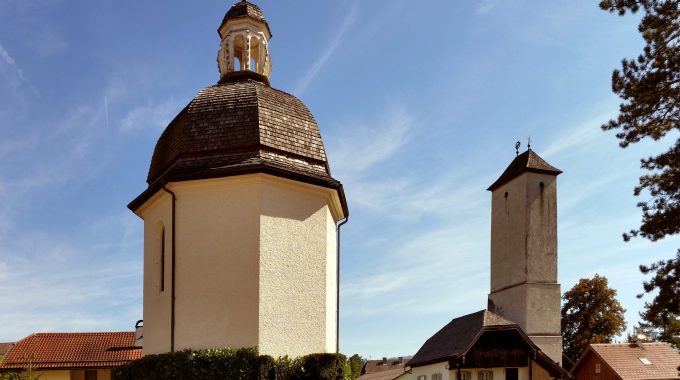
A European Journey #96 – Oberndorf bei Salzburg (Austria)
In the nineteenth century, an Austrian priest wrote a poem beginning with the words Stille Nacht, Heilige Nacht, Silent Night, Holy Night. Little did he know that his poem of six stanzas would become a carol sung in many languages all over the world.
At first, the circumstances that gave birth to this famous Christmas carol seemed catastrophic. But to discover the details of the story, we will need to visit a village called Oberndorf bei Salzburg. It is located by the Salzbach river, which also forms the border with Germany. As its name indicates, Oberndorf is at a short distance from the city of Salzburg.
Just a hundred metres away from the bank of the river lies a small octagonal chapel on the top of a grassy mound. It is called Stille-Nacht-Kapelle and it was built in 1935 on the site of a previous church named after St. Nicholas which had been destroyed because of regular floods. Inside the chapel, there are two stained-glass windows depicting the creators of Silent Night and their hometowns: the writer Joseph Mohr with Oberndorf and the composer Franz Gruber with Arnsdorf. So let’s find out who these men were.
Josephus Franciscus Mohr, simply known as Joseph Mohr, was born on the 11th of December 1792 in Salzburg, just a few streets from the house where Wolfgang Amadeus Mozart had died only a year before. Sadly, Joseph was born out of wedlock, and thus never knew his father. Because of this, his mother, who was called Anna Schoiberin, had to find her son a godfather. Finally, the only person who accepted was a man named Joseph Wohlmuth, and a curious detail about him was that he was in fact the last executioner of the city.
Thanks to Johann Nepomuk Hiernle, the choirmaster of the cathedral, Joseph Mohr received a Christian education and became a member of the choir. This was the beginning of an entire life dedicated to the church. At the age of sixteen, Mohr joined the seminary of Kremsmünster Abbey in Upper Austria and later on returned to Salzburg to train for priesthood in the city’s lyceum. At the time a special permission from the pope was required for someone born out of wedlock to become priest. Thankfully the permission was granted and Mohr was ordained priest in 1815.
The second man on the stained-glass windows is Franz Gruber. He was born in Hochburg-Ach, approximately twenty-five kilometres North from Oberndorf, in 1787. As a boy, he worked with his father as a weaver. However, to his father’s initial dismay, his great passion was music, which he pursued secretly in the organ loft of the local church with the help of a local churchman. Later on, he became a music teacher at Arnsdorf, just a few kilometres away from Oberndorf, where he also got married. It was during these years that Franz Gruber became a friend of Joseph Mohr.
Shortly before the midnight mass of Christmas 1818, Joseph Mohr had a shocking realisation: the organ of his church was not working. This was a majorsetback as music formed a vital part of Christmas celebrations. In such a situation, Mohr could only pray for a miracle. Suddenly he remembered a poem that he had written some time before about the nativity.
After locating the poem, Mohr dashed to Gruber’s house, and asked him to compose a melody for the lyrics. Although they had little time, Gruber succeeded in providing the words with a suitable melody to be played with a guitar. And so, after a few last minute rehearsals, Franz Gruber performed Silent Night with the choir during Christmas mass right where we are today.
After Christmas, a repairman from a nearby valley came to fix the organ and, asking Franz Gruber to test it, heard him play Silent Night. The repairman was so moved by the carol that he asked if he could take it back to his parish. Soon Silent Night spread like wildfire throughout the German-speaking nations, without Gruber and Mohr knowing anything about it. A few years later, it even reached the Protestant King of Prussia, Friedrich-Wilhelm IV, during a performance at the imperial church in Berlin. The king was so moved by the carol that he ordered it to be played throughout his kingdom. However, when he asked who the author of the carol was, no name could be given to him. He thus ordered an enquiry to be made to discover its creators.
Less than a year later, St. Peter’s monastery in Salzburg was contacted, where Franz Gruber’s son was actually a choir boy.Naturally he was able to point out that the music was his father’s composition. This is how Franz Gruber and Joseph Mohr were discovered. The fame of the carolcontinues to grow even after their death, and today it is sung in over a hundred and twenty languages all around the world.
Similarly to Joseph Mohr who couldn’t use his broken organ for the Christmas midnight mass, another Joseph couldn’t find a suitable place for his pregnant wife in Bethlehem eighteen centuries earlier. Finally, just as God gave Mohr a solution that would eventually bless the whole world, He also provided a barn for Mary to give birth to the Son of God, the Saviour from our sins and King of the whole creation, Jesus Christ, whose kingdom will cover the whole world.
See you next time somewhere else in Europe.
(with special thanks to Jukka Rauhala for the Silent Night end tune)
Cédric Placentino
Follow A European Journey here.
Picture: Wikipedia – user: Michael Burgholzer – License: https://creativecommons.org/licenses/by-sa/4.0/legalcode
IMPORTANT NOTE: This stage of A European Journey will be the last published on the website of the Schuman Centre for European Journey. From January 2021, you will be able to follow A European Journey on https://www.truthandtransformation.org

This Post Has 0 Comments